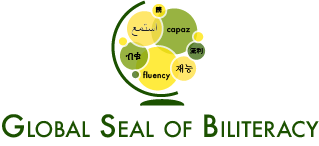March Goals & Activities
March’s Theme: “Plan for Adventure”
March’s Goal: Our goal for our first month is to develop learner autonomy through self-reflection and goal-setting. Noted author, Daniel Pink, challenges our thinking as educators when he says, “Control leads to compliance; autonomy leads to engagement.” In other words, when we turn control of the learning journey over to students, engagement and progress are heightened. Success then hinges upon three things that educators must provide:
An exciting learning outcome (what students will be able to do)
Formative assessment and feedback (how students will know they are making progress)
“Visible Learning” or evidence of success (how students know that goal has been achieved)
Helping students chart their pathway toward language proficiency meets these criteria.
For recognition, submit projects by April 15, 2023
PREPARE - Educators (1st week)
Join our Global Classroom Pair-Share FaceBook page.
Connect with your classroom partner(s) and get to know one another. Please let us know if your partner is unresponsive so we can assist.
Add your geolocation pin to the map.
Please review the guidelines for our project and activities and keep in mind student privacy concerns.
Feel free to explore our list of ICT resources – learning new technology tools is part of the fun of this project. (link to list or page)
Consider watching the Global C.R.E.D. 2020 video Tools to Guide Student Reflection and Goal-Setting https://theglobalseal.com/cred-2020-041
AWARE - Educators
Here are resources for you to expand your knowledge of how language proficiency is measured on the CEFR (Common European Framework of Reference for Languages) and ACTFL proficiency scales and how they can be used to support language learner autonomy and curriculum development. The CEFR scale is commonly used around the world, while the ACTFL scale is primarily used in the United States. For educators and students who want to test to certify their language skills with a serial-numbered, digitally shareable credential, the Global Seal of Biliteracy certifies on both the CEFR (B1, B2, and C1) and ACTFL (Intermediate-Mid, Advanced-Low, and Advanced-High) scales.
Learn more about the CEFR Scale.
Learn more about the ACTFL Scale.
PREPARE - Students
Learner autonomy begins with helping your students better understand how their language skills can be measured using either the CEFR or ACTFL proficiency scale. This begins with improving your own knowledge of the scale that relates best to your students (see the AWARE section above) and then sharing a little about your chosen scale (CEFR or ACTFL) with your students.
Consider adding a poster or bulletin board to your classroom to highlight the proficiency scale and class descriptors or goals (you can find images online) such as these:
Using the resources above, you might want to highlight the likely levels of your class and a few of their descriptors. For example, “Our class is likely to be mostly at the A2 level which means we can . . .” To level up to the B1 or Intermediate-Mid level, we will want to work on ---, ---, and ---.” Keep it simple, focusing on the most important descriptors like moving from short simple sentences to longer sentences with multiple parts. Proficiency is NOT about specific points of grammar or pronunciation.
AWARE – Students
Self-Assessment – Ask your students to take the 6 mini self-assessments. They will be asked to reflect (in English) on their ability to do an “I CAN” Statement and then to respond with the appropriate Emoji. At the end of each short mini assessment, they will be given a likely score that corresponds to a proficiency level. Be sure to have your students record their scores. After students have identified their likely level in each of their skill areas of reading, listening, speaking, and writing, they will be able to chart their journey and set goals. Part of their discovery will be that they will most likely be at a different level in each skill according to their natural strengths and weaknesses. It may surprise you, but it is an anomaly if a student was at the same level in each skill.
Celebrate your Strength! Have students share with each other, their paired classroom, and/or their parents their language skill strength (highest score). For most learners, their strength will be a full level (or higher) above their weak area. You can even have a “Celebrate! Party” by grouping students (in your own classroom or with your classroom matches) by skill strength. In each group, students can discuss the activities and/or careers that match their strengths. For example: students who excelled at listening will find it easier to understand music lyrics or foreign films and might be a good interpreter because they’re quicker to understand the other language. For younger students, they could be given an “I’m GREAT at LISTENING” sticker or nametag to wear. Strength Group photos can be taken and displayed or shared on our FB page.
ACTIVITY “Proficiency Roadmap 101” – Have students create their own Proficiency Roadmap using an app such as canva, genial.ly, or visme or create one for your students to all use.
DECLARE – Ask students to identify 1 area (2 at the most) where they want to grow their skills.
· Watch a “LEVEL-UP” your Language Learning: 10 Strategies video for the skill(s) you want to improve. Each video is about 15-20 minutes long but has 10 different ideas they can try.





